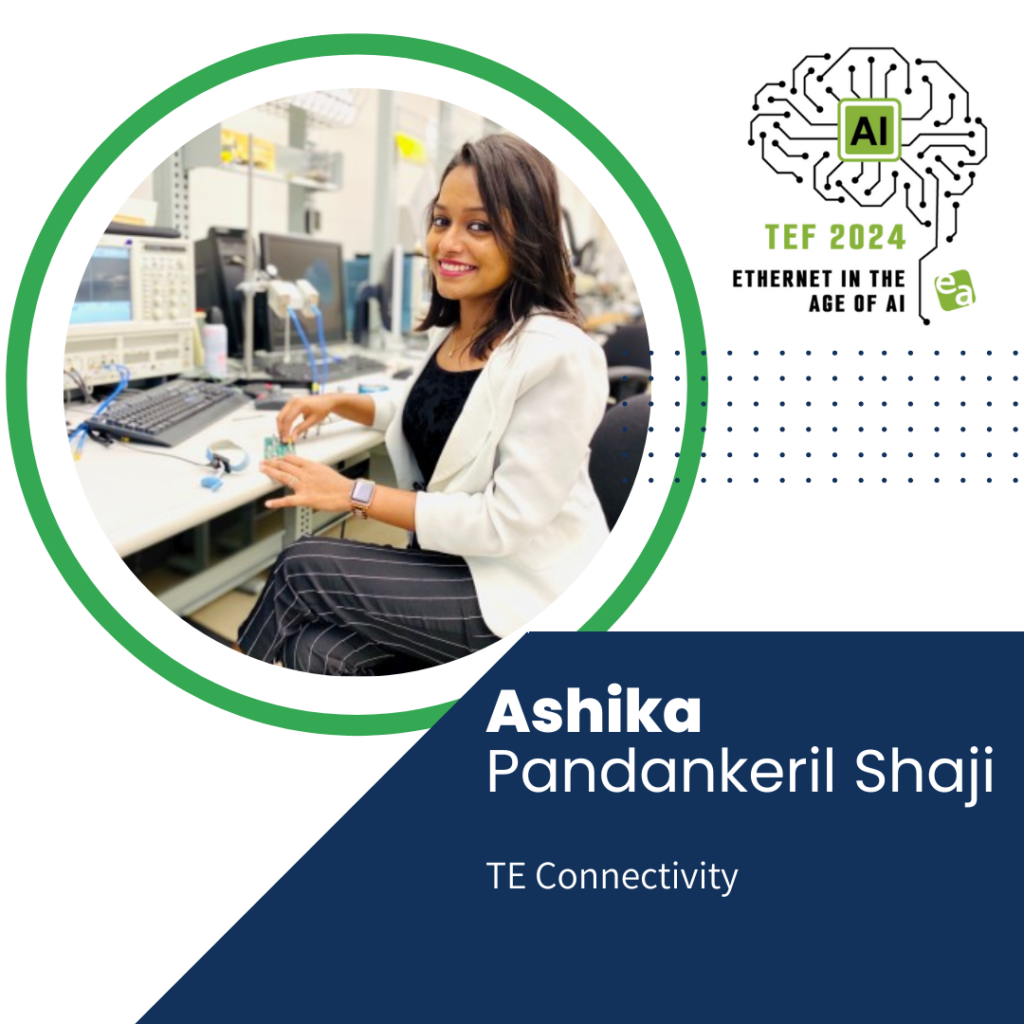Ashika Pandankeril Shaji – TE Connectivity
 Bio: Ashika Pandankeril Shaji is a Senior System Architect at TE Connectivity. With a strong foundation in electrical and eomputer engineering from her Bachelor’s and Master’s degrees, she previously excelled as a Signal Integrity Engineer focused on high-speed applications. Ashika’s role at TE Connectivity involves developing cutting-edge solutions that meet modern technological demands. Known for her technical expertise and innovative approach, she has made significant contributions to her field.
Bio: Ashika Pandankeril Shaji is a Senior System Architect at TE Connectivity. With a strong foundation in electrical and eomputer engineering from her Bachelor’s and Master’s degrees, she previously excelled as a Signal Integrity Engineer focused on high-speed applications. Ashika’s role at TE Connectivity involves developing cutting-edge solutions that meet modern technological demands. Known for her technical expertise and innovative approach, she has made significant contributions to her field.
Her career is marked by a commitment to excellence and a passion for staying at the forefront of technological advancements.
Presentation Abstract: The data center industry is undergoing rapid evolution driven by the integration of open systems, advancements in artificial intelligence (AI), deeper learning algorithms, and the proliferation of cloud storage solutions. This transformation has led to burgeoning demands for bandwidth, necessitating a shift towards 400G per lane Ethernet, which is expected to replace 100G and 200G per lane deployments more swiftly than previous generational transitions. Achieving this milestone requires a pivotal shift in signal-encoding strategies, particularly with challenges in implementing PAM4 modulation for 400Gbps transmission rates.
From an interconnect perspective, achieving reliable signal transmission at 400Gbps faces significant hurdles. Loss at Nyquist frequencies around 100GHz, exacerbated by PAM4 modulation, poses conflicts with industry demands for extended electrical channel reach. Crosstalk and resonances further complicate matters at frequencies beyond 80GHz, highlighting the need for advanced modulation schemes while aiming to maintain Nyquist frequencies below 70GHz for optimal power efficiency and low-latency fabric requirements.
The adoption of pluggable interfaces offers advantages in installation, maintenance, serviceability, and reliability per lane, accommodating both copper and optical media seamlessly. However, existing form factor limitations present obstacles to achieving a robust 400G per lane interface. Some of these limitations are driven by signal integrity factors such as insertion loss, skew, return loss, and crosstalk, all integral to system functionality. Issues include return loss degradation and resonances at mating interfaces due to pad stubs, which also introduce mechanical challenges when reducing pad length. Addressing these concerns may necessitate a redesign of mating contacts and pad structures. Furthermore, constraints in current form factor designs, such as limitations on adding ground pins at mating zones and complexities in ground shielding structures, pose risks for manufacturing issues and ground re sonances. A streamlined connector interface and improved impedance control are proposed solutions to mitigate these challenges.
In conclusion, advancing to 400G per lane Ethernet represents a significant leap for the datacenter industry, driven by the demand for higher bandwidth and performance. Overcoming the technical challenges associated with signal encoding, interconnect reliability, and form factor design will be crucial in realizing the full potential of next-generation data transmission technologies.
This presentation summarizes the key technological challenges and advancements related to the transition to 400G per lane Ethernet in data centers, focusing on signal encoding strategies, interconnect reliability issues, and form factor design limitations.



